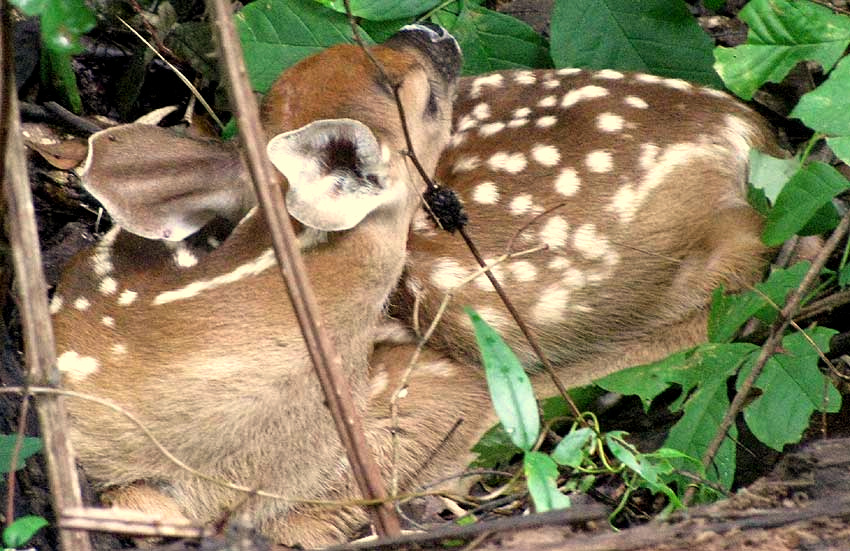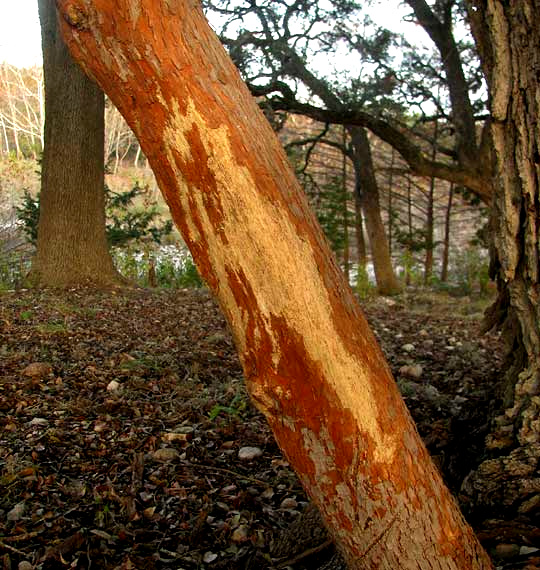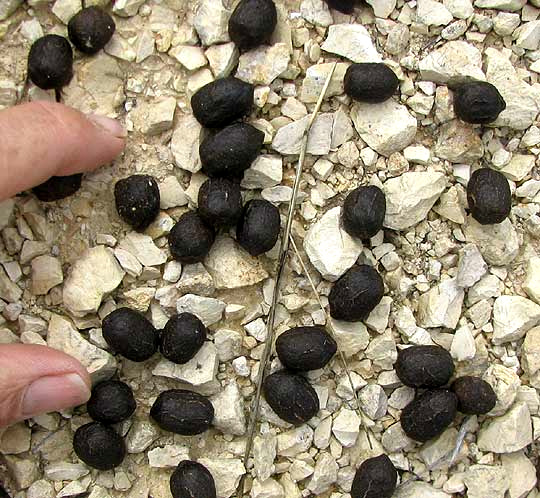Excerpts from Jim Conrad's
Naturalist Newsletter

from the July 15, 2012 Newsletter issued from the woods of the Loess Hill Region a few miles east of Natchez, Mississippi, USA
FAWN BEING INVISIBLE
Wanting to photograph the hairs on the undersurface of a maple leaf, I carried the leaf into an opening where the light was better, turned on the camera, and for a tiny fraction of a second before the camera was set on macro and focused on the leaf, it seemed that in my viewfinder there stood the image of a spotted fawn -- the young of a White-tailed Deer, ODOCOILEUS VIRGINIANUS. Not ten minutes earlier I'd spooked such a fawn, who had erupted from behind a tree 15 feet (4.5m) away as I walked through the woods, but that fawn had fled like a fox half-flying, half fluttering on willowy legs, taking me a few moments to figure out what it was. But there'd not been time for a picture. How... ?
Reflexively and with my mouth dropped open I looked to where the camera had been pointed, and there ten feet away (3m) was what is shown above.
Beside a fallen log and fairly hidden from view by herbage all around, except for the small opening through which I peered, the fawn moved not at all. The morning was overcast, drizzly and the light was very dim, and that's one reason I'd managed to see the fawn, for its camouflage mimicked a sunlight-dappled forest floor, not a somber, rain-darkened one.
I didn't want the fawn to run away so I snapped the picture and moved on. Only when the image was on my laptop screen could I fully admire what I'd seen. Especially striking was how one of the fawn's ears was pointed exactly toward me monitoring my movements without the fawn having to look at me. On the other ear two ticks could be seen sucking blood. I think the white pattern on the fawn's black snout is a sticky spider web earlier nosed into.
If my camera hadn't by itself framed and focused on the fawn, I don't think I'd have ever seen it, despite being so close and facing toward it. The strategy of not moving is almost magical in the way it renders one "invisible." It seems that dumb luck -- good or bad -- can trump just about any strategy.
from the November 24, 2013 Newsletter issued from the Frio Canyon Nature Education Center in the valley of the Dry Frio River in northern Uvalde County, southwestern Texas, on the southern border of the Edwards Plateau; elevation ~1750m (~5750 ft); N29.62°, W99.86°; USA
BUCK RUBS
"Buck rubs" -- where male deer rub their antlers against tree trunks to remove the velvet -- are commonly seen here in the fall. A buck rub on a young Texas Liveoak growing along the little Dry Frio River is shown below:

How do you know that this trunk damage isn't caused by a porcupine or feral pig? When porcupines debark trunks they leave tooth marks, which aren't seen in our picture. Debarking caused by feral pigs is more similar because they also damage the tree by rubbing on the trunk to remove mud and parasites. However, pig rubs tend to be near wallows, where they wallow in mud, so often their rubs are dirty, plus often you can find stiff pig hairs, or bristles, in cracks of the rub tree's bark. Pig bristles may be of a different color than deer hairs.
If you watch a buck while rubbing, you'll see that he's doing more than rubbing velvet off his antlers. Bucks generally rub the bases of their antlers and their forehead skins against the trees, and may stop to smell or lick the rubbed area. This happens because buck rubs serve as a buck's calling card for potential mates, and as a challenge to other male deer. The buck's scent is left on the trunk, the odor being produced by special glands. Dr. Jon Gassett conducted a chemical analysis of volatile chemicals associated with a buck's forehead region and identified 57 different compounds.
This raises the question of whether deer can recognize by the odor the individuals who marked the rubs. Also, it's been noticed that following a sparring match between two bucks the "loser" frequently licks the forehead region of the dominant animal.
An article in Field & Stream Magazine says that individual bucks make from 69 to 538 rubs each year, with dominant bucks averaging 300 or more. One study found older bucks making more than 1200 rubs during the roughly 90 day rubbing period, which translates to about 15 rubs per day! Dominant bucks tend to make many more rubs than subordinates, so a good guess is that when dominant bucks mark their range with rubs they're not only announcing their presence but also their dominance.
from the February 17, 2013 Newsletter issued from the valley of the Dry Frio River in northern Uvalde County, southwestern Texas, on the southern border of the Edwards Plateau; elevation ~1750m (~5750 ft); N29.62°, W99.86°; USA
DEER PELLETOLOGY
Deer wander around the cabin every night, often leaving their scat, or poop. The other morning two long donations had been dribbled across the gravel driveway, a small part of which is shown with my fingers providing scale below:

Deer scat is produced in pellet form similar to that of rabbit poop, except that rabbit pellets are spherical while those of deer are more oblong. Some trackers say that most deer pellets have a dimple on one end and a point on the other, and that's the case with some but not all the pellets in the picture. These dimples and points are just a small part of what can be noticed about deer scat, in the science we can call deer pelletology.
Why pellets? There are several reasons.
First, deer, along with rabbits, sheep and other pellet-dropping mammals, have much more efficient digestive systems than many other mammals, including humans. Deer are ruminants with four chambered stomachs in which bacteria break down the otherwise indigestible cellulose into nutrients the body can use. Deer guts are about 28 feet long (8.5m), so there is plenty of length along which not only nutrients can be absorbed through intestinal walls but also water. Therefore, what comes out of a deer is a surprisingly small fraction of what goes in, and normally what exits is fairly hard and compact. The drier the forage eaten, the harder the pellets and the more strung-out they tend to be when deposited. The moister the forage, the softer and stickier or even mushy the pellets, and the more clumped the deposit tends to be.
This doesn't explain why deer turds are pellet-shaped. However, any human who doesn't drink enough fluid notices the next morning that what comes out is hard and pellet-like. It seems that dry poop tumbling through long intestines just naturally comes out in pellet form.
There's still the question, though, of why deer pellets should be about the same size of those of rabbits, even though deer are much larger than rabbits. Why don't deer produce baseball-sized pellets?
One explanation is that it's a basic law of Nature that small spheres have larger surface areas per unit volume than larger spheres. If your body wants to extract as many nutrients and as much water from your pellets as possible, these things are more efficiently absorbed through the relatively large surface areas of many small pellets than through the relatively small surface areas of a few large ones.
The average number of pellets in an ordinary deer movement, by the way, is 75. And a study done back in 1940 found that deer defecate on the average 12.6 times a day.
from the January 20, 2002 Newsletter issued from the woods of the Loess Hill Region a few miles south of Natchez, Mississippi; elevation ~200ft (~60m), ~N31.42°, ~W91.41°; USA
FART-BLOW
When a deer is frightened it reflexively alerts other deer by issuing a kind of loud blow-sound and by stamping the ground. Similarly it is a natural function of a good hermit to fart whenever the need be. At dusk once this week I was standing as silently and quietly as I could next to a field of blackberry brambles, hoping to spot a rare species of sparrow that sometimes sings at dusk. Without thinking much about it, I let a fart rip. Unbeknownst to me, a deer had walked up right behind me, probably not seeing me because of the darkness and because I was so still. My detonation occasioned the deer's sharp blow and this in turn scared me out of my wits. There must have been a moment when both deer and I were airborne with our wheels spinning.
from the January 6, 2002 Newsletter issued from the woods of the Loess Hill Region a few miles south of Natchez, Mississippi; elevation ~200ft (~60m), ~N31.42°, ~W91.41°; USA
DEER SCRAPES
In the woods I've been finding spots on the forest floor about the size of a kitchen table, looking as if someone had kicked the leaves away, then scratched the exposed ground with a pitchfork. Actually, that's probably exactly what has happened. Our paying hunters are up to some of their "old hunting tricks."
For a long time hunters have believed that such "scrapes," as the are called, are created only by dominant bucks scraping the ground with their front hooves. A doe in heat discovers the scrape and feels compelled to leave her scent by urinating on the spot. The buck then revisits his scrape and follows the scent trail to his doe. At least this is what most hunters seem to believe. They likewise believe that if they watch trails leading to scrapes they may be able to pick off amorous individuals passing to and from their message board. Also they figure that they might attract deer by creating their own scrapes with boots and ground-scratchers.
The scrape story isn't all that simple. A young woman by the name of Karen Alexy, working on her Ph.D. at Clemson University, is studying deer scrapes systematically with motion-activated video cameras. She's shown that this "old hunting trick" is based on misunderstandings of deer behavior.
For instance, she's found that not just dominant bucks make scrapes but rather a scrape may be the product of as many as 13 or more bucks, and these may include low-ranking first-year ones. On the other hand, some scrapes may have hardly any visitors at all. Thus all along hunters have been wrong to assume that big-antlered dominant males range around their scrape keeping small-antlered ones away, and that all scrapes were equally used. Alexy also has found that most deer-visits to scrapes take place deep in the night, not at dawn and dusk when hunters usually go out.
In fact, only about half of the "scent message- boards" deer produce involve ground scrapes. The message-board begins when bucks rub low-hanging branches with their foreheads, antlers, or sometimes chew on the branches, presumably leaving their scent there. Ground scrapes are only added later, and that only sometimes. The odors present at a marked spot are far more important to deer than ground-scrapes.
The most interesting thing, however, is that even Karen Alexy admits to not understanding more than a little about what really is going on with all this scent-marking and scrape-making.
I did not need this to remind me that in this forest I am immersed in many such mysteries. At night I hear rustlings, snarls, grunts, thumps and bumps, flutterings of wings, scamperings and the like that I cannot begin to explain. Sometimes it simply seems impossible that the animals conceivably found here could be making such combinations of sounds.